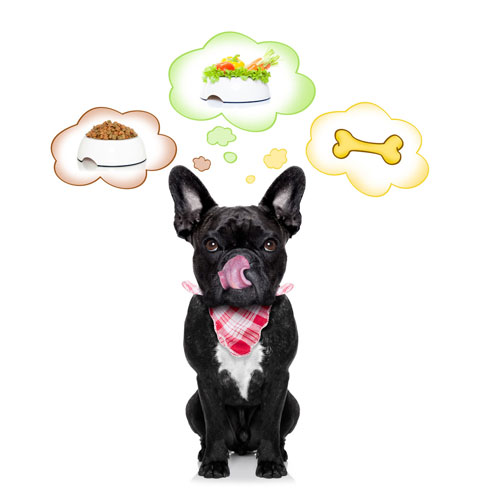What Every Pet Owner Should Know
By Tiffany L. Mitchener, DVM
What is a Raw Food Diet?
A raw food diet differs significantly from what one thinks of the standard, processed pet food diet. A raw food diet is not cooked. It often contains muscle meat, bones (whole or ground), organ meat (such as liver or kidney), raw eggs, vegetables, fruit, and some dairy (often yogurt). Many owners follow online recipes to create a home prepared raw diet. There are also commercially processed raw diets that can be purchased at a pet store; these are often frozen or freeze dried. Combination diets are also available which contain a blend of grains, vegetables and vitamins; these require an owner to simply add the raw meat.
Potential Benefits of a Raw Diet

Many pet owners were very frightened by the 2007 widespread recall of contaminated commercial pet food that was responsible for multiple pet deaths. Many owners feel that home-prepared raw diets give them more control over what their pets are eating.
But it is important to note that raw diets have not been thoroughly researched by the veterinary community. Carefully crafted studies need to be performed before raw diets can be fully and fairly evaluated.
Why Are Raw Diets Not Endorsed by the FDA or the AVMA?
The FDA and AVMA do not endorse raw diets due to potential threats to both pet and owner health. Raw meat can contain bacteria and/or other parasites that can be harmful to animals and humans alike. Salmonella, E. coli, and Listeria bacteria have all been found in raw diets. Pets can become sick from the bacterial or parasitic contamination, or they can become carriers for these infectious agents and then routinely shed them in their feces. This can put the whole public at risk, especially any immuno-compromised individuals. It is interesting to note that due to these risks, as of 2010 the Delta Society’s Pet Partners Program no longer allows animals eating raw meat-based diets to participate in their therapy animal programs.
Another issue is that due to their inexact composition, raw pet food diets can contain nutritional imbalances that can harm pets if fed long term. Many raw pet food diets are low in calcium and phosphorus. The lack of these essential nutrients can lead to brittle bones, bone fractures, and dental issues. If a raw diet is particularly high in liver meat, this can lead to increased vitamin A levels that can be toxic.
Finally, the presence of whole bones in many raw food diets can lead to choking risks, broken teeth, internal intestinal punctures or obstruction.
What About Treats?
It is important to note that even if a pet is fed a cooked commercial diet, other components of a pet’s diet, such as pig ears, raw hides, or bully sticks, may not be fully cooked. Dogs that consume these treats are at risk of bacterial contamination, broken teeth, choking, intestinal punctures, and obstruction.
Who Should Avoid a Raw Diet?
Due to their potential nutritional imbalances, raw diets should not be fed to puppies that are at higher risk of developing bone deformities and growth issues. Animals with cancer, late stage kidney disease, or severe liver failure should not be fed raw diets.
Are There Any Other Diet Options?
Given that some owners prefer not to feed their pets a commercial diet, is a raw diet the only alternative? One widely overlooked option is for pet owners to feed their pets a cooked homemade diet designed by a veterinary nutritionist. Consult your veterinarian for advice on where to find recipes for nutritionally balanced home cooked meals. Any diet changes for your pet should only be made under the guidance of your veterinarian.
Raw pet food diets continue to grow in popularity among pet owners. Owners should feed these diets with care knowing their limitations and potential risks to both their animals and themselves. Further study is needed by the veterinary community to fully understand if the potential benefits of feeding our pets raw diets outweigh the risks. Until more is known, pet owners should consider feeding their pets a high quality standard processed pet food or a veterinary nutritionist designed homemade cooked diet.